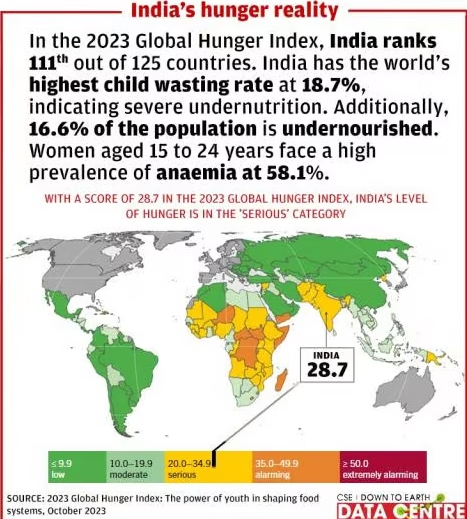The Global Hunger Index is an important indicator of hunger at international and regional levels. Where does India stand in 2024 and how much is it a matter of ‘serious’ concern?
Why in the news?
India is ranked 105th among 127 countries in the Global Hunger Index (GHI) 2024, indicating a ‘serious’ level of hunger, along with Afghanistan and Pakistan, which also face hunger challenges.
According to the Global Hunger Index released on 10th October 2024, the hunger levels in 42 countries are at alarming levels, making the goal of Zero Hunger by 2030 unattainable.
At this pace of progress, the world will not even attain a low hunger level until 2160. The world’s GHI score is 18.3, which is considered moderate in the severity of hunger scale.
Global Hunger Index
The GHI is published by Concern Worldwide and Welt hungerhilfe annually to measure and track hunger at global, regional, and national levels. The purpose of the report is to create awareness and understanding of the struggle against hunger and call attention to those areas of the world where hunger levels are highest and there is a need for additional efforts.

GHI is calculated based on a formula that combines four indicators that together capture the multidimensional nature of hunger: (The source of the following definitions is globalhungerindex.org)
- Undernourishment: the share of the population whose caloric intake is insufficient;
- Child stunting: the share of children under the age of five who have low height for their age, reflecting chronic undernutrition;
- Child wasting: the share of children under the age of five who have low weight for their height, reflecting acute undernutrition; and
- Child mortality: the share of children who die before their fifth birthday, reflecting in part the fatal mix of inadequate nutrition and unhealthy environments.
The 2024 GHI reflects that multiple factors are posing challenges in attaining Zero Hunger. The challenges include large-scale armed conflicts, climate change indicators that are worsening faster than expected, high food prices, market disruptions, economic downturns, and debt crises in many low- and middle-income countries.
The report highlights the link between Gender inequality, climate change, and hunger. Gender is intertwined with climate and food security challenges in ways that respective policies and interventions often ignore. Women and girls are typically hardest hit by food insecurity and malnutrition. They also suffer disproportionately from the effects of weather extremes and climate emergencies.
Six countries – Somalia, Yemen, Chad, Madagascar, Burundi, and South Sudan- have levels of hunger considered alarming. This is the result of widespread human misery, undernourishment, and malnutrition.
India ranked 105th out of 125 countries in the Global Hunger Index 2024, with a score of 27.3, indicating a serious level of hunger. Child wasting is particularly high in India. Child undernutrition in India goes hand in hand with the poor nutritional status of mothers, suggesting an intergenerational pattern of undernutrition and underscoring the need for attention to maternal health nutrition and infant feeding.

Hunger
The Food and Agriculture Organization of the United Nations (FAO) defines hunger as food deprivation, or undernourishment, as the habitual consumption of too few calories to provide the minimum dietary energy an individual requires to live a healthy and productive life, given that person’s sex, age, stature, and physical activity level.
Hidden Hunger
In India, we suffer largely from “hidden hunger” which does not always manifest itself in an emaciated appearance. It is a hunger caused by the constant or recurrent lack of food of sufficient quality and quantity.
It is the deprivation of vitamins and minerals, essential micronutrients that are necessary for proper growth, physical fitness, and mental development.
India’s GHI score of 27.3 is a cause for concern, especially when compared to its South Asian neighbours like Bangladesh, Nepal, and Sri Lanka, which fall into the “moderate” category
The performance of India on various parameters of GHI:
- 13.7 per cent of India’s population suffers from undernourishment,
- 35.5 per cent of children under the age of five are stunted
- 18.7 per cent experience child wasting and
- 2.9 per cent of children do not reach their fifth birthday.
The policy recommendations made in the document include strengthening accountability to international law and the enforceability of the right to adequate food, promoting gender-transformative approaches to food systems and climate policies and programs, and making investments that integrate and promote gender, climate, and food justice.
